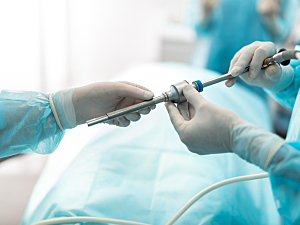One of the first steps in laparoscopy (conventional or robotic-assisted) is to fill the abdominal cavity with inert carbon dioxide gas, which establishes the surgical field and helps provide hemostasis. Toward the end of surgery, the gas is often manually compressed out of the abdomen. Inevitably some of the gas remains, but it is gradually absorbed and metabolized postoperatively.
However, residual gas (residual pneumoperitoneum, RPP) can be problematic if the patient re-presents to a hospital due to postoperative abdominal pain. CT is very sensitive for detecting abdominal free air, and it’s often impossible to determine whether the air is RPP or attributable to a more ominous etiology such as perforation of a hollow organ.
Venkat M. Ramakrishnan, MD, PhD, clinical fellow in surgery at Brigham and Women’s Hospital, and colleagues in Switzerland recently became the first to systematically assess RPP with CT after laparoscopy. In Diagnostics (Basel), they present a table to help clinicians determine whether RPP at a particular time point after robotic-assisted laparoscopic prostatectomy (RALP) is in the expected range.
Methods
The researchers chose RALP because it’s a common, standardized laparoscopic procedure. They conducted a prospective, observational study of 31 patients who underwent RALP between August 2018 and January 2020, had no major complications or blood loss requiring transfusion, and had no visceral injury noted intraoperatively or on later CT scans.
Patients were scanned on the third, fifth, and seventh postoperative days (POD), although scans on POD5 or POD7 took place only if RPP was observed at the preceding time point(s).
RPP Values
There was a wide variance in RPP, but only a small number of patients had large volumes, and on average RPP was nearly completely resolved within a week:
- POD3—Mean RPP volume 38 mL (median, 10 mL; maximum, 247 mL)
- POD5—Mean 20 mL (median, 1.4 mL; maximum, 221 mL)
- POD7—Mean 10 mL (median, 0.09 mL; maximum, 112 mL)
The decrease from POD3 to POD5 was statistically significant, as was the decrease from POD5 to POD7. By POD7, RPP was completely absent in 10 patients.
Demographic Factors
Preoperative weight and body mass index were negatively correlated with RPP and were the demographic factors that most strongly affected RPP. When RPP was plotted as a function of stratified BMI, obese patients always demonstrated significantly lower RPP volumes than normal-weight or overweight patients. People with abundant visceral fat may be better able to resorb RPP.
A Predictive Model
The researchers used preoperative weight to develop a formula that predicted RPP with 95% credibility. Based on that formula, they provide a table that shows expected RPP for POD3, 4, 5, 6, and 7 after RALP according to a man’s BMI.
Future work will be needed to expand the tool to other surgical procedures in additional populations and genders.
